Stephanie Carroll's Blog: Become a VIP Reader Today!, page 5
October 7, 2013
What Every Fiction Writer Ought to Know About Becoming a Published Novelist! Free In-Depth Email Series! Plus a .99 Cent Giveaway and Halloween Sale!
Scroll Down to Get to the What's it's really Like to be an Author Email Series Info
Blogging Break
Due to the below information, I will be taking a break from writing posts for my blog =(
I want you to have quality content on these blog posts, and if I am too busy to create them then I'm not going to give you garbage. You guys are awesome and deserve the best! I will be back in November to let you know what's coming next!
Miss you guys! Look for me on Twitter and Facebook. I'll be around.
Have a Happy Halloween!
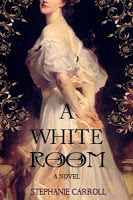 Special 10-Day Halloween Sale!!!
Special 10-Day Halloween Sale!!!
A White Room eBook Edition Will Be Available for $0.99 cents! Marked Down from $3.99 for a Limited Time!October 21st through October 31st!
Buy A White RoomeBook Now for $0.99 cents at:
Amazon & Barnes & Noble
Halloween Giveaway!
So you know the giveaway box to the right? The one that says I need so many Twitter and Facebook followers to end the Giveaway? Well I'm ending it! Regardless of how many followers I have, that giveaway will end on Oct. 31st! Happy Halloween!
Win a signed copy of A White Room or one of two $25 Amazon Gift Cards!!!
Giveaway ends on October 31st!
Like @CarrollBooks on Twitter or Facebook to Qualify then enter here:
Major Halloween Giveaway!
Coming Soon - If You Want it Too!
What it’s Really like to be a Published Author
Free Email Series
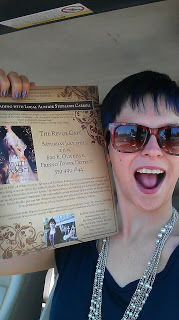 Want to know what it’s like to be a writer and a published author? How does the publishing industry work? What does a writer go through while writing a novel? What does a writer go through while publishing a novel? How do you publish a novel? What happens after you publish? How do I as an author make decisions about books you might be reading one day? There are tons of books, blogs, and information out there on the internet about these topics, but what is it really like to be a published author? Is it easy or hard? What does a person go through to get there? I want to really show you what it's like: the good, the bad, the mistakes, the successes, the really hard times, the really good times, and the truth!
Want to know what it’s like to be a writer and a published author? How does the publishing industry work? What does a writer go through while writing a novel? What does a writer go through while publishing a novel? How do you publish a novel? What happens after you publish? How do I as an author make decisions about books you might be reading one day? There are tons of books, blogs, and information out there on the internet about these topics, but what is it really like to be a published author? Is it easy or hard? What does a person go through to get there? I want to really show you what it's like: the good, the bad, the mistakes, the successes, the really hard times, the really good times, and the truth!Join my email list to pre-register for this series!
I am currently gauging for reader interest in this series. If I don’t receive sign-ups, I’m not going to create it. By signing up, you will pre-register to receive the content when it comes out. If the project does not move forward, you will receive ONLY ONE email to let you know. This email list is not connected to my general list and emails are never shared.
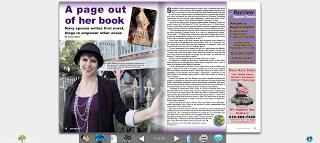
Sign Up Here to be the First to Receive This Series!
Published on October 07, 2013 09:39
September 26, 2013
Christopher's Ectoplastic Travels Through Time: James Braid & The Origin of Hypnotism
By Christopher Thisse
You may or may not know that magic is sometimes called a “Mystery Art”. This is because the origins of magic delve so far back into history that we can’t even trace them reliably. I am fairly sure that at some point a cave man realized that if he held a rock a certain way, the other cave men couldn’t see it and they would revere him for being able to suddenly be holding a rock.
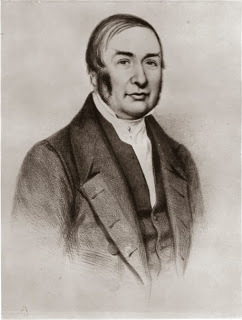 James Braid. This Image is in the Public Domain. Copyright has expired.I just haven’t been able to find that cave man yet. Africa is a big place to search for one cave man.
James Braid. This Image is in the Public Domain. Copyright has expired.I just haven’t been able to find that cave man yet. Africa is a big place to search for one cave man.Another of the original mystery arts is hypnosis.
This is a subject that has piqued my interests lately. I don’t know about you, but I am a fan of going back to the origin when learning about a subject. That means a trip back to the 1800s for this performance artist.
I went back to find a man named Franz Mesmer. Like the word “Mesmerized”.
Franz Mesmer was the first man to really hypnotize a person. He believed that there was a force that existed between all people which he referred to as animal magnetism. He and his followers believed that they were able to basically force their animal magnetism over people and put those people under their control. This was usually done through a highly ritualized procedure which included robes and glass harmonicas and other such trappings. This was called Mesmerism.
This was near the time that scientific experimentation was really taking hold. Mesmer’s procedures and beliefs became passé and intellectually inclined gentlefolk were wise to avoid it if they wanted to maintain a career. But there was a surgeon, named James Braid, who became interested in the phenomenon when he saw one of Mesmer’s students, Charles Lafontaine, performing feats of mesmerism on November 13th, 1841 in Manchester.
Braid did not believe that the subjects were under any form of animal magnetism or will of the mesmerist. However, the subjects were clearly in some kind of altered state. He noticed that one phenomenon that was clearly true was that the subjects were unable to open their eyes during key moments of the process. He took this fact and decided that the eyes must have a very important role in the act of putting people into this trance state.
He also theorized that the process need not involve a mesmerist at all. So he went home and developed an ‘upward and inward squint’. Using this method he was able to put himself into a trance and thus demolished the idea that an outside entity (such as a mesmerist) was required for this to happen.
Braid developed the techniques further and on November 22nd, 1841 he did a performance of hypnosis (not yet named such), using a Mr. J. A. Walker as his subject. Soon after, on November 27th he gave a lecture on the subject at Manchester Athenæum in which he was able to demonstrate that he could produce the effects created by Lafontaine without the need to touch any of the subjects.
Wanting to distance himself from the concepts of mesmerists (which was of vital importance if he wished to maintain a respected reputation) he declared the need to separate this valid phenomenon from the claims of mesmerists. He associated the trance state with sleep, so he went with the name neurypnology (“nervous sleep”). After some time he renamed it to neuro-hypnotism (Named for the Greek god of Sleep, Hypnos), then shortened it to hypnotism.
He later realized that the state had little to nothing to do with sleep, and attempted to popularize monoideism, but the term hypnotism had already taken firm hold and wasn’t going anywhere.
Braid maintained that both a mental and physical fixation of the gaze and attention was all that was required, and that this procedure only activated a state which was hard wired into all human beings. He successfully used hypnosis to treat a variety of ailments and injuries, but was firm in the belief that hypnotism was not a miracle cure-all. It was only another form of possible treatment. He also maintained that only medical professionals should ever use it in a clinical sense.
Braid was what was known at the time as a gentleman scientist. He did his research with no affiliation with any institution or government organization, which allowed him to conduct his experiments with a fairly free hand. Due to his diligence and experimentation, the entire field of hypnosis was legitimized. He could validly be considered the world’s first hypnotherapist.
Hypnotism is a fascinating and largely misunderstood thing. Braid used it to treat physical ailments. We use it to make people think they’re a chicken. As you do.
Further reading:http://www.historyofhypnosis.org/james-braid/http://www.jamesbraidsociety.com/jamesbraid.htmhttp://en.wikipedia.org/wiki/James_Braid_%28surgeon%29
Check Out Christopher's New Blog Ectoplastic Travels!
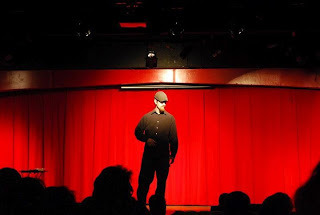
Christopher Thisse is a time traveling psychic magician. Not all of those things are true. He has been performing semi-professionally for over eight years, starting in a small circus troupe in Providence, Rhode Island. When he moved to Fresno he shifted his focus to magic and now works for Ellusionist, one of the largest magic companies in the world. His troupe, Of The Fireflies, has performed for some of the largest events in the Central Valley and Fresno area of California including Trashique, Freedom Fest, CMAC’s Anniversary Event and many ArtHop events. When not doing impossible things in front of awe-inspired crowds, Christopher can often be found writing urban fantasy themed Steampunk stories, cooking, tending bar at parties, or training his German shepherd puppy. And if all else fails, look for him out in the Black Rock Desert, Or on Facebook!
Published on September 26, 2013 11:26
September 18, 2013
Read this for Halloween! Review “This House is Haunted” by John Boyne
For the Halloween reading challenge I recommended RIP VIII, I started with John Boyne’s new book This House is Haunted. I don’t usually review books on this blog, but I decided to since I recommended the reading challenge.
About This House is Haunted
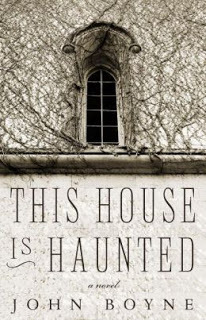 1867. Eliza Caine arrives in Norfolk to take up her position as governess at Gaudlin Hall on a dark and chilling night. As she makes her way across the station platform, a pair of invisible hands push her from behind into the path of an approaching train. She is only saved by the vigilance of a passing doctor.
1867. Eliza Caine arrives in Norfolk to take up her position as governess at Gaudlin Hall on a dark and chilling night. As she makes her way across the station platform, a pair of invisible hands push her from behind into the path of an approaching train. She is only saved by the vigilance of a passing doctor.When she finally arrives, shaken, at the hall she is greeted by the two children in her care, Isabella and Eustace. There are no parents, no adults at all, and no one to represent her mysterious employer. The children offer no explanation. Later that night in her room, a second terrifying experience further reinforces the sense that something is very wrong.
From the moment she rises the following morning, her every step seems dogged by a malign presence which lives within Gaudlin’s walls. Eliza realises that if she and the children are to survive its violent attentions, she must first uncover the hall’s long-buried secrets and confront the demons of its past.
About the Author
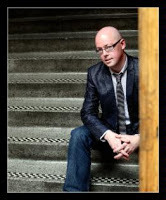 John Boyne
John Boyne
John Boyne was born in Ireland in 1971 and is the author of eight novels including the international bestsellers Mutiny on the Bounty, The Absolutist and The Boy In The Striped Pyjamas which won two Irish Book Awards, topped the New York Times bestseller list in the US and was made into a Miramax feature film. His novels are published in over 40 languages. He lives in Dublin.
www.johnboyne.com
Buy on Amazon US! Buy on Amazon UK!
My Review
My rating: 4.5 out of 5 stars.
What I Enjoyed
I enjoyed the majority of the book, and I think it worked really well as what it was meant to be, a gothic ghost story, playing off of the tradition of many classics. I really enjoyed it for the tradition it was written in.
First Line: “I blame Charles Dickens for the death of my father.”
I did love that first line. Charles Dickens doesn’t really have any major role in the book, but I liked that the author incorporated the historical author because as the back cover of the copy I received explained: Boyne wrote this book in Dickensian prose. The whole Dickensian prose actually made me nervous because I’ve tried to read Dickens and it is wordy, but thankfully Boyne didn’t get carried away with that aspect. His book is very readable and nicely done as far as historical English writing goes. As someone who writes historical fiction, I can tell you that is not easy.
I also really enjoyed the effect this ghost story had on me. Through the first quarter of the book, before I knew what was going on, I was really freaked out but in a fun way. I found myself jumping at the sound of loud noises throughout the day even when I hadn’t been reading the book and that effect was pretty fun in itself. I did stay up late on multiple nights trying to get more reading done.
I really think this is a great book for Halloween!
Buy on Amazon US!
Buy on Amazon UK!
Why Not Five Stars?
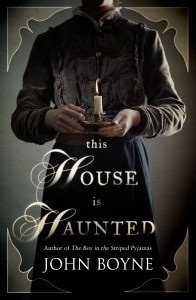 Okay, there were two things that bothered me, but they are small and very possibly my own issues as opposed to something the author did.
Okay, there were two things that bothered me, but they are small and very possibly my own issues as opposed to something the author did.First thing: The book starts out very mysterious which was good but eventually we want to know what’s going on and so does Eliza and so she finds out. Eliza Cain learns the history of the house, discovers the tragedies that befell previous inhabitants, and realizes the house is haunted and she is in immediate danger. Yet, she stays. It wasn’t very clear in my opinion why she stayed. Toward the end, it becomes clear that the motivation is the children but for a long while the children were just creepy, and it wasn’t clear that they were the motivation so I just kept wondering why she stuck around.
Second thing: Once the backstory of the house was explained, the story became less creepy and more predictable. I knew what was going on long, long before the first person protagonist Eliza did, which kind of made her seem aloof. I’m not saying this is outright terrible though. Some people like predictability, but I personally don’t. If you have read my novel, you guys know I don’t like predictability.
However, in John Boyne’s defense, he took on a very difficult literary task, to recreate a classic genre. Do you use tropes to fit in with the genre or do you try for unique and risk not fitting the genre? That’s a difficult balance, but overall I think Boyne stuck with his intention, which was to recreate the joy of being chilled by a classic Gothic tale. He accomplished that and I enjoyed the book for that reason.
Buy on Amazon US!
Buy on Amazon UK!
I wasn’t paid to do this review. I received an Advanced Reading Copy.
Have you read This House is Haunted? What's your review?
Published on September 18, 2013 10:57
September 4, 2013
Check out RIP VIII Reading Challenge!
 photo credit: Beauteous Babe via photopin cc Have you guys heard of this yet? It's a Halloween reading challenge! Check it out.
photo credit: Beauteous Babe via photopin cc Have you guys heard of this yet? It's a Halloween reading challenge! Check it out.RIP VIII!!!
Several bloggers have suggested my book A White Room would be a great book for this event. Hint, hint. Digital winky face. That suggestion inspired me to do a Halloween promotion this October. I'll tell you guys about it soon, but basically A White Room e-edition will be available at a discounted price for a limited time.
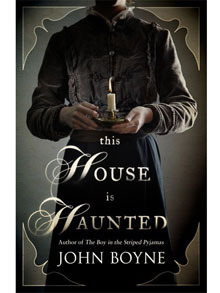 Although I'm reading an advanced copy of John Boyne's This House is Haunted that will also be spectacular for this challenge. It's Gothic, it's historical, it's written in Dickensian prose but in a good way. It's got me looking over my shoulder!
Although I'm reading an advanced copy of John Boyne's This House is Haunted that will also be spectacular for this challenge. It's Gothic, it's historical, it's written in Dickensian prose but in a good way. It's got me looking over my shoulder! Buy This House is Haunted on Amazon US!
Buy This House is Haunted on Amazon UK!
What scary books have your read or want to read this Halloween? Let's do this challenge!
Published on September 04, 2013 10:28
August 28, 2013
Christopher's Ectoplastic Travels in Time: How a middle-school prank started a religion
By Christopher Thisse
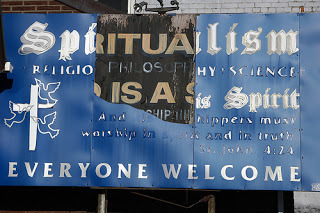 photo credit: designwallah via photopin ccThe fall leaves in upstate New York are gorgeous. I highly recommend a trip to see them. The other day I was strolling through New York in 1888 when I stumbled across the October 21stedition of the New York World, with the confession from Margaret (Maggie) Fox. Have you heard of the Fox sisters? They accidentally created a religion.In the winter of 1847 the younger Fox Sisters, Maggie and Katy decided to play a prank on their easily frightened mother. They began creating rapping sounds by tying strings to apples and bouncing them on the floor. Or they would toss the apples onto the floor which would create an odd sound every time it rebounded. Intrigued and frightened, their mother investigated. Being superstitious, she believed it was supernatural in origin.
photo credit: designwallah via photopin ccThe fall leaves in upstate New York are gorgeous. I highly recommend a trip to see them. The other day I was strolling through New York in 1888 when I stumbled across the October 21stedition of the New York World, with the confession from Margaret (Maggie) Fox. Have you heard of the Fox sisters? They accidentally created a religion.In the winter of 1847 the younger Fox Sisters, Maggie and Katy decided to play a prank on their easily frightened mother. They began creating rapping sounds by tying strings to apples and bouncing them on the floor. Or they would toss the apples onto the floor which would create an odd sound every time it rebounded. Intrigued and frightened, their mother investigated. Being superstitious, she believed it was supernatural in origin. Planning to do a grand finale for their prank, the sisters decided to have an active conversation with the ghost they were creating. They enticed the ghost, whom they named Mr. Splitfoot, to rap against the walls in the patterns they created by snapping their fingers. To further prove it, they mimed snapping their fingers and the ghost created the appropriate number of raps.
Their mother took this performance to heart and began questioning the ghost. The girls created the appropriate answers, perhaps fearing that if they confessed then they would be in trouble. Their mother was so convinced; she asked the spirit if she could bring others to speak with it. Not knowing what else to do, the sisters made the ‘ghost’ agree to this. Neighbors were brought in and asked questions which were answered so acutely that the sisters began to gather a minor following.
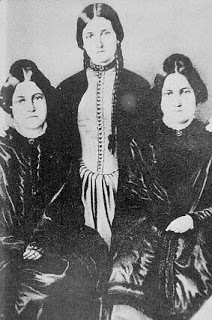 Fox Sisters From Left: Margaret, Kate & Leah. US-PD
Fox Sisters From Left: Margaret, Kate & Leah. US-PD Their older sister, Leah, was a single mother who saw opportunity. She went to Hydesville to speak to the younger sisters and got them to divulge the truth. Instead of turning them out, though, she became their manager of sorts. She pushed them to do more performances. The sisters eventually moved to Rochester and continued their séances. One of the first couples to witness these performances was a prominent Quaker couple who were also important local figures who were pushing certain political agendas such as women’s suffrage and equality of all people regardless of race, creed, nationality, or gender. They became the first ‘Spiritualists’ per se.Much of what had happened up until that point could be attributed to the religious climate of the country at the time. Popular religious theorists had come up with the idea that the spiritual world was in constant contact with the physical world and we humans simply couldn’t tell. It was theorized that someday soon someone would find a way to speak to the dead. Enter the Fox sisters.
Pushed by their older sister (Even when they were doubtful and wished to stop) the Fox Sisters continued performing séances and traveling the world. They did séances for prominent politicians, actors, writers, etc. They became wealthy and famous.
But the guilt of deceiving the public took its toll. They developed drinking problems. Their lives were troubled and they suffered intense mental stress in trying to maintain the duel reality. In 1888, Margaret Fox gave an exclusive confession for the sum of $1,500. She hoped it would end the deception that she considered Spiritualism to be. She detailed how she and her sister had developed the method of popping their toes in such a way to produce raps. A year later, she recanted her confession in writing. Within five years, both younger sisters were dead and buried in paupers’ graves.
 photo credit: Psychology Pictures via photopin ccBut to this day, Spiritualism lives on. One can still find mediums giving séances for donations all across the nation and overseas.
photo credit: Psychology Pictures via photopin ccBut to this day, Spiritualism lives on. One can still find mediums giving séances for donations all across the nation and overseas. But how does this relate to magic, I hear you say. Simple. The methods that the Fox Sisters created have never been duplicated, but other methods took their place. The methods of table tipping, table rapping, Ouija, pendulums, etc., are still used to this day by the bizarre magicians of the world. A lovely evening of wine and conversations with the Fox Sisters did wonders for my own act.
Further reading:Fox Sisters on HistoryNet.com Fox Sisters on ParanormalEncyclopedia.com - The Confession
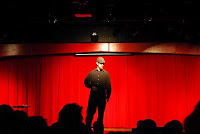 Christopher Thisse is a time traveling psychic magician. Not all of those things are true. He has been performing semi-professionally for over eight years, starting in a small circus troupe in Providence, Rhode Island. When he moved to Fresno he shifted his focus to magic and now works for Ellusionist, one of the largest magic companies in the world. His troupe, Of The Fireflies, has performed for some of the largest events in the Central Valley and Fresno area of California including Trashique, Freedom Fest, CMAC’s Anniversary Event and many ArtHop events. When not doing impossible things in front of crowds, Christopher can often be found writing urban fantasy themed Steampunk stories, cooking, tending bar at parties, or training his German shepherd puppy. And if all else fails, look for him out in the Black Rock Desert. Or on Facebook!
Christopher Thisse is a time traveling psychic magician. Not all of those things are true. He has been performing semi-professionally for over eight years, starting in a small circus troupe in Providence, Rhode Island. When he moved to Fresno he shifted his focus to magic and now works for Ellusionist, one of the largest magic companies in the world. His troupe, Of The Fireflies, has performed for some of the largest events in the Central Valley and Fresno area of California including Trashique, Freedom Fest, CMAC’s Anniversary Event and many ArtHop events. When not doing impossible things in front of crowds, Christopher can often be found writing urban fantasy themed Steampunk stories, cooking, tending bar at parties, or training his German shepherd puppy. And if all else fails, look for him out in the Black Rock Desert. Or on Facebook!
Published on August 28, 2013 13:57
August 21, 2013
The Victorian Gothic: What is a Gothic Novel Exactly?
Today I'm starting out my new series The Victorian Gothic, which will be about Victorian Gothic Literature. During my blog tour over the summer, a variety of book bloggers called my novel a gothic novel, and now I'm really wanting to dive in and learn more about this genre. I figure you're the perfect audience to take with me!

Crumbling Ruins: L Grove via photopin ccMy first post on this series though is going to be hosted on Oh, For The Hook of a Book, which was the first book review site to compare my novel to some of the classics and which is giving away a couple free copies of my e-book, so go on over and enter before the giveaway ends and checkout my new giveaway page on my website to stay up to date on all the contest fun!
Here's a taste of the post you'll get at Oh, For the Hook of a Book:
What Exactly is The Gothic Novel?
By Stephanie Carroll
Reviewers have compared my debut novel A White Roomto the classic gothic novels The Haunting of Hill House by Shirley Jackson and Rebeccaby Daphne Du Maurier (thank you Oh, For the Hook of a Book!). I was so delighted when this happened because I wrote my novel in a way I felt was reminiscent of gothic fiction, but when I looked at other gothic novels, mine didn’t seem very gothic in comparison. That led me to wonder, what exactly is a gothic novel?
* I’m not an expert on the gothic novel, so I am including my sources for where I got my information and for you in case you’d like to do further research.
The Origin of Gothic
The term gothic actually derives from the Visigoths and Ostrogoths (the barbarians) who conquered Rome in the 5th Century A.D. After the collapse of Rome, the world fell into a dark age and the Goths were ultimately forgotten until artists and architects rediscovered Greco-Roman culture during the Renaissance. They began to refer to certain (barbaric) architecture built during the middle ages as gothic even though it wasn’t necessarily built by the Goths. These were castles, mansions, and abbeys, many of which were in ruins.
The Gothic Novel – UC Davis
The Original Gothic Novel
Writers developed the first gothic novels in England from 1790 to 1830. These works were termed gothic because they took place in and around gothic buildings and architecture. Many themes and conventions developed that also came to define the gothic novel. In addition to usually taking place in a mansion, castle, or abbey, these buildings were often in ruins in the story, which created a mood of mystery and dread because it reminded readers of a world lost, a fallen society, or a world in decay. The hero was usually isolated in some way, and the villain was usually a man who had fallen from grace and represented the epitome of evil.
These novels also dealt with serious real-world fears like murder, rape, and sin, but on an exaggerated level and often times through the supernatural, so the gothic novel also became associated with horror fiction. Some examples of gothic literature from this time period are Matthew G. Lewis's The Monk and Ann Radcliffe's The Mysteries of Udolpho.
The Gothic Novel – UC Davis
Victorian Gothic
Another form of the gothic novel came about in the Victorian Era starting in the 1880s (my kind of gothic). The setting, again, played a role and....
Read the rest at Oh, For the Hook of a Book! And enter the Giveaway!

Crumbling Ruins: L Grove via photopin ccMy first post on this series though is going to be hosted on Oh, For The Hook of a Book, which was the first book review site to compare my novel to some of the classics and which is giving away a couple free copies of my e-book, so go on over and enter before the giveaway ends and checkout my new giveaway page on my website to stay up to date on all the contest fun!
Here's a taste of the post you'll get at Oh, For the Hook of a Book:
What Exactly is The Gothic Novel?
By Stephanie Carroll
Reviewers have compared my debut novel A White Roomto the classic gothic novels The Haunting of Hill House by Shirley Jackson and Rebeccaby Daphne Du Maurier (thank you Oh, For the Hook of a Book!). I was so delighted when this happened because I wrote my novel in a way I felt was reminiscent of gothic fiction, but when I looked at other gothic novels, mine didn’t seem very gothic in comparison. That led me to wonder, what exactly is a gothic novel?
* I’m not an expert on the gothic novel, so I am including my sources for where I got my information and for you in case you’d like to do further research.
The Origin of Gothic
The term gothic actually derives from the Visigoths and Ostrogoths (the barbarians) who conquered Rome in the 5th Century A.D. After the collapse of Rome, the world fell into a dark age and the Goths were ultimately forgotten until artists and architects rediscovered Greco-Roman culture during the Renaissance. They began to refer to certain (barbaric) architecture built during the middle ages as gothic even though it wasn’t necessarily built by the Goths. These were castles, mansions, and abbeys, many of which were in ruins.
The Gothic Novel – UC Davis
The Original Gothic Novel
Writers developed the first gothic novels in England from 1790 to 1830. These works were termed gothic because they took place in and around gothic buildings and architecture. Many themes and conventions developed that also came to define the gothic novel. In addition to usually taking place in a mansion, castle, or abbey, these buildings were often in ruins in the story, which created a mood of mystery and dread because it reminded readers of a world lost, a fallen society, or a world in decay. The hero was usually isolated in some way, and the villain was usually a man who had fallen from grace and represented the epitome of evil.
These novels also dealt with serious real-world fears like murder, rape, and sin, but on an exaggerated level and often times through the supernatural, so the gothic novel also became associated with horror fiction. Some examples of gothic literature from this time period are Matthew G. Lewis's The Monk and Ann Radcliffe's The Mysteries of Udolpho.
The Gothic Novel – UC Davis
Victorian Gothic
Another form of the gothic novel came about in the Victorian Era starting in the 1880s (my kind of gothic). The setting, again, played a role and....
Read the rest at Oh, For the Hook of a Book! And enter the Giveaway!
Published on August 21, 2013 08:55
August 7, 2013
The Hysterical Victorian: My Theory on Why Hysteria Exploded in the late Nineteenth Century
I'd like to introduce my new segment The Hysterical Victorian, which will be focusing on all kinds of topics about the insane and hysterical because this is one of my specialties. My novel "A White Room" involved in-depth research into female hysteria, and I am very knowledgeable on the subject, which many people find crazily interesting so why not have a segment?
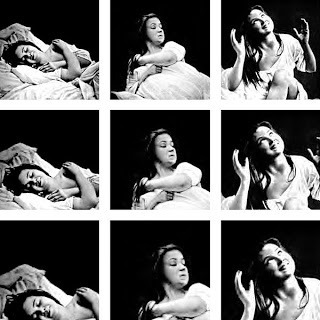 Public Domain Photo taken by Jean-Martin Charcot in 1878 during his experiments using hypnosis to treat hysteria patients.
Public Domain Photo taken by Jean-Martin Charcot in 1878 during his experiments using hypnosis to treat hysteria patients.
For today's post, I'd like to share an opinion I have formed during my research on hysteria. For those of you who don't know much about hysteria, I highly recommend you watch my "vlog on The Yellow Wallpaper," but a quick definition - hysteria was a disease involving a variety of "nervous complaints." In the the late nineteenth century and turn of the century, hysteria was considered an epidemic among women. The condition was believed to be caused by the uterus wandering the body and causing emotional disturbances; however, the symptoms were so broad almost anything could lead to a diagnosis. Cures ranged from bed rest to sensory deprivation, the water cure, genital stimulation, admission into a lunatic asylum, or even removal of the reproductive organs, which is where we get our term hysterectomy.
Hysteria had been around for some time, but the amount of cases exploded during the late nineteenth century and turn of the century, but why?
One of the things that is well known about hysteria is that a lot of the women who were diagnosed were simply acting out, rebelling, or behaving in a manner that was unacceptable. Much of historical study has focused on the fact that many of these rebellious women were intentionally or unintentionally rebelling on behalf of women's rights. At this time, it was believed that women were naturally submissive, domestic, pure, and pious (the four values of the Cult of Domesticity). These values went beyond goals and were understood as a woman's natural place. When women didn't act in a way that was considered normal or natural, it was seen as a symptom.
But it wasn't just rebellious and revolutionary women who were diagnosed. Women who were actually suffering with depression, anxiety, and other real mental illnesses were also diagnosed too.
So back to the question, why were so many women diagnosed with hysteria at this time period?
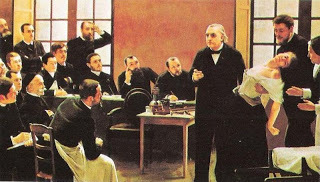 Professor Jean-Martin Charcot demonstrates hypnosis on a "hysterical" patient. This image is in the public domain because it's copyright has expired.My opinion is that the diagnoses increased due to an increase in both rebellion and mental illnesses like depression and anxiety among women. Increased rebellion and many mental illnesses (like depression or anxiety) are in response to dissatisfaction in something. I believe that the unhappiness of rebellious women and increase in depression in women stemmed from the same thing. Their lives lacked meaning or purpose.
Professor Jean-Martin Charcot demonstrates hypnosis on a "hysterical" patient. This image is in the public domain because it's copyright has expired.My opinion is that the diagnoses increased due to an increase in both rebellion and mental illnesses like depression and anxiety among women. Increased rebellion and many mental illnesses (like depression or anxiety) are in response to dissatisfaction in something. I believe that the unhappiness of rebellious women and increase in depression in women stemmed from the same thing. Their lives lacked meaning or purpose.
*A commenter pointed out that not all mental illnesses are in response to a stimulant but can be caused by chemical imbalances or other issues that are completely out of the patients control or environment. This is 100 percent true and I am not trying to include those cases in this theory. I am specifically referring to women getting depressed or having some other psychological problem in response to a factor in their lives.*
Prior to the Industrial Revolution, women were really important to the home. They had to make food from scratch, they had to make all the clothes, they educated the children, they provided home medicine, and did just about everything by hand. Their role in the home was extremely important and couldn't be done by others unless they were rich enough to pay people to do it.
However, with the Industrial Revolution, there came a variety of machines and new products that made life easier for women in the home, but that also diminished the importance of their roles. Women's skills were less important after factories started producing things like canned goods, washing machines, and clothing. Their roles had less meaning and value than in previous generations.
This was a slow transitional process that occurred in increments, but the overall result was that women were experiencing dissatisfaction with their current lots in life. It's obvious that women's rights fighters were born out of this dissatisfaction, but what isn't as obvious is that many women who were dissatisfied didn't see fighting for their rights as an option or didn't realize it would resolve their problems. These women grew depressed, anxious, or developed another type of mental disturbance that would lead to a diagnosis of hysteria.
Of course I'm not saying every single case of hysteria fit into these two generalities. What I am saying is that it is my opinion that the explosion in cases of hysteria was a reflection of the increase of unhappiness among women after their roles and primary purpose was diminished in the home.
For further reading on this topic:
The New York Times: The Pseudoscience of Hysteria
Jean-Marcot Charcot
PubMed.gov on Hysterectomy a Historical Perspective
The Hysterical Female
 Public Domain Photo taken by Jean-Martin Charcot in 1878 during his experiments using hypnosis to treat hysteria patients.
Public Domain Photo taken by Jean-Martin Charcot in 1878 during his experiments using hypnosis to treat hysteria patients.
For today's post, I'd like to share an opinion I have formed during my research on hysteria. For those of you who don't know much about hysteria, I highly recommend you watch my "vlog on The Yellow Wallpaper," but a quick definition - hysteria was a disease involving a variety of "nervous complaints." In the the late nineteenth century and turn of the century, hysteria was considered an epidemic among women. The condition was believed to be caused by the uterus wandering the body and causing emotional disturbances; however, the symptoms were so broad almost anything could lead to a diagnosis. Cures ranged from bed rest to sensory deprivation, the water cure, genital stimulation, admission into a lunatic asylum, or even removal of the reproductive organs, which is where we get our term hysterectomy.
Hysteria had been around for some time, but the amount of cases exploded during the late nineteenth century and turn of the century, but why?
One of the things that is well known about hysteria is that a lot of the women who were diagnosed were simply acting out, rebelling, or behaving in a manner that was unacceptable. Much of historical study has focused on the fact that many of these rebellious women were intentionally or unintentionally rebelling on behalf of women's rights. At this time, it was believed that women were naturally submissive, domestic, pure, and pious (the four values of the Cult of Domesticity). These values went beyond goals and were understood as a woman's natural place. When women didn't act in a way that was considered normal or natural, it was seen as a symptom.
But it wasn't just rebellious and revolutionary women who were diagnosed. Women who were actually suffering with depression, anxiety, and other real mental illnesses were also diagnosed too.
So back to the question, why were so many women diagnosed with hysteria at this time period?
 Professor Jean-Martin Charcot demonstrates hypnosis on a "hysterical" patient. This image is in the public domain because it's copyright has expired.My opinion is that the diagnoses increased due to an increase in both rebellion and mental illnesses like depression and anxiety among women. Increased rebellion and many mental illnesses (like depression or anxiety) are in response to dissatisfaction in something. I believe that the unhappiness of rebellious women and increase in depression in women stemmed from the same thing. Their lives lacked meaning or purpose.
Professor Jean-Martin Charcot demonstrates hypnosis on a "hysterical" patient. This image is in the public domain because it's copyright has expired.My opinion is that the diagnoses increased due to an increase in both rebellion and mental illnesses like depression and anxiety among women. Increased rebellion and many mental illnesses (like depression or anxiety) are in response to dissatisfaction in something. I believe that the unhappiness of rebellious women and increase in depression in women stemmed from the same thing. Their lives lacked meaning or purpose.*A commenter pointed out that not all mental illnesses are in response to a stimulant but can be caused by chemical imbalances or other issues that are completely out of the patients control or environment. This is 100 percent true and I am not trying to include those cases in this theory. I am specifically referring to women getting depressed or having some other psychological problem in response to a factor in their lives.*
Prior to the Industrial Revolution, women were really important to the home. They had to make food from scratch, they had to make all the clothes, they educated the children, they provided home medicine, and did just about everything by hand. Their role in the home was extremely important and couldn't be done by others unless they were rich enough to pay people to do it.
However, with the Industrial Revolution, there came a variety of machines and new products that made life easier for women in the home, but that also diminished the importance of their roles. Women's skills were less important after factories started producing things like canned goods, washing machines, and clothing. Their roles had less meaning and value than in previous generations.
This was a slow transitional process that occurred in increments, but the overall result was that women were experiencing dissatisfaction with their current lots in life. It's obvious that women's rights fighters were born out of this dissatisfaction, but what isn't as obvious is that many women who were dissatisfied didn't see fighting for their rights as an option or didn't realize it would resolve their problems. These women grew depressed, anxious, or developed another type of mental disturbance that would lead to a diagnosis of hysteria.
Of course I'm not saying every single case of hysteria fit into these two generalities. What I am saying is that it is my opinion that the explosion in cases of hysteria was a reflection of the increase of unhappiness among women after their roles and primary purpose was diminished in the home.
For further reading on this topic:
The New York Times: The Pseudoscience of Hysteria
Jean-Marcot Charcot
PubMed.gov on Hysterectomy a Historical Perspective
The Hysterical Female
Published on August 07, 2013 12:07
The Hysterical Victorian: Why Hysteria Exploded in the late Nineteenth Century
I'd like to introduce my new segment The Hysterical Victorian, which will be focusing on all kinds of topics about the insane and hysterical because this is one of my specialties. My novel "A White Room" involved in-depth research into female hysteria, and I am very knowledgeable on the subject, which many people find crazily interesting so why not have a segment?
 Public Domain Photo taken by Jean-Martin Charcot in 1878 during his experiments using hypnosis to treat hysteria patients.
Public Domain Photo taken by Jean-Martin Charcot in 1878 during his experiments using hypnosis to treat hysteria patients.
For today's post, I'd like to share an opinion I have formed during my research on hysteria. For those of you who don't know much about hysteria, I highly recommend you watch my "vlog on The Yellow Wallpaper," but a quick definition - hysteria was a disease involving a variety of "nervous complaints." In the the late nineteenth century and turn of the century was considered an epidemic among women. The condition was believed to be caused by the uterus wandering the body and causing emotional disturbances; however, the symptoms were so broad almost anything could lead to a diagnosis. Cures ranged from bed rest to sensory deprivation, the water cure, genital stimulation, admission into a lunatic asylum, or even removal of the reproductive organs, which is where we get our term hysterectomy.
Hysteria had been around for some time, but the amount of cases exploded during the late nineteenth century and turn of the century, but why?
One of the things that is well known about hysteria is that a lot of the women who were diagnosed were simply acting out, rebelling, or behaving in a manner that was unacceptable. Much of historical study has focused on the fact that many of these rebellious women were women's rights fighters. At this time, it was believed that women were naturally submissive, domestic, pure, and pious (the four values of the Cult of Domesticity). These values went beyond goals and were understood as a woman's natural place. When women didn't act in a way that was considered normal or natural, it was seen as a symptom.
But it wasn't just rebellious and revolutionary women who were diagnosed. Women who were actually suffering with depression, anxiety, and other real mental illnesses were diagnosed too.
So back to the question, why were so many women diagnosed with hysteria at this time period?
 Professor Jean-Martin Charcot demonstrates hypnosis on a "hysterical" patient. This image is in the public domain because it's copyright has expired.My opinion is that the diagnoses increased due to an increase in both rebellion and mental illnesses like depression and anxiety among women. Increased rebellion and most mental illnesses are symptoms of dissatisfaction in something. I believe that the unhappiness of rebellious women and mentally ill women stemmed from the same thing. Their lives lacked meaning or purpose.
Professor Jean-Martin Charcot demonstrates hypnosis on a "hysterical" patient. This image is in the public domain because it's copyright has expired.My opinion is that the diagnoses increased due to an increase in both rebellion and mental illnesses like depression and anxiety among women. Increased rebellion and most mental illnesses are symptoms of dissatisfaction in something. I believe that the unhappiness of rebellious women and mentally ill women stemmed from the same thing. Their lives lacked meaning or purpose.
Prior to the Industrial Revolution, women were really important to the home. They had to make food from scratch, they had to make all the clothes, they educated the children, they provided home medicine, and did just about everything by hand. Their role in the home was extremely important and couldn't be done by others unless they were rich enough to pay people to do it.
However, with the Industrial Revolution, there came a variety of machines and new products that made life easier for women in the home, but that also diminished the importance of their roles. Women's skills were less important after factories started producing things like canned goods, washing machines, and clothing. Their roles had less meaning and value than in previous generations.
This was a slow transitional process that occurred in increments, but the overall result was that women were experiencing dissatisfaction with their current lots in life. It's obvious that women's rights fighters were born out of this dissatisfaction, but what isn't as obvious is that many women who were dissatisfied didn't see fighting for their rights as an option or didn't realize it would resolve their problems. These women grew depressed, anxious, or developed another type of mental disturbance that would lead to a diagnosis of hysteria.
Of course I'm not saying every single case of hysteria fit into these two generalities. What I am saying is that it is my opinion that the explosion in cases of hysteria was a reflection of the increase of unhappiness among women after their roles and primary purpose was diminished in the home.
For further reading on this topic:
The New York Times: The Pseudoscience of Hysteria
Jean-Marcot Charcot
PubMed.gov on Hysterectomy a Historical Perspective
The Hysterical Female
 Public Domain Photo taken by Jean-Martin Charcot in 1878 during his experiments using hypnosis to treat hysteria patients.
Public Domain Photo taken by Jean-Martin Charcot in 1878 during his experiments using hypnosis to treat hysteria patients.
For today's post, I'd like to share an opinion I have formed during my research on hysteria. For those of you who don't know much about hysteria, I highly recommend you watch my "vlog on The Yellow Wallpaper," but a quick definition - hysteria was a disease involving a variety of "nervous complaints." In the the late nineteenth century and turn of the century was considered an epidemic among women. The condition was believed to be caused by the uterus wandering the body and causing emotional disturbances; however, the symptoms were so broad almost anything could lead to a diagnosis. Cures ranged from bed rest to sensory deprivation, the water cure, genital stimulation, admission into a lunatic asylum, or even removal of the reproductive organs, which is where we get our term hysterectomy.
Hysteria had been around for some time, but the amount of cases exploded during the late nineteenth century and turn of the century, but why?
One of the things that is well known about hysteria is that a lot of the women who were diagnosed were simply acting out, rebelling, or behaving in a manner that was unacceptable. Much of historical study has focused on the fact that many of these rebellious women were women's rights fighters. At this time, it was believed that women were naturally submissive, domestic, pure, and pious (the four values of the Cult of Domesticity). These values went beyond goals and were understood as a woman's natural place. When women didn't act in a way that was considered normal or natural, it was seen as a symptom.
But it wasn't just rebellious and revolutionary women who were diagnosed. Women who were actually suffering with depression, anxiety, and other real mental illnesses were diagnosed too.
So back to the question, why were so many women diagnosed with hysteria at this time period?
 Professor Jean-Martin Charcot demonstrates hypnosis on a "hysterical" patient. This image is in the public domain because it's copyright has expired.My opinion is that the diagnoses increased due to an increase in both rebellion and mental illnesses like depression and anxiety among women. Increased rebellion and most mental illnesses are symptoms of dissatisfaction in something. I believe that the unhappiness of rebellious women and mentally ill women stemmed from the same thing. Their lives lacked meaning or purpose.
Professor Jean-Martin Charcot demonstrates hypnosis on a "hysterical" patient. This image is in the public domain because it's copyright has expired.My opinion is that the diagnoses increased due to an increase in both rebellion and mental illnesses like depression and anxiety among women. Increased rebellion and most mental illnesses are symptoms of dissatisfaction in something. I believe that the unhappiness of rebellious women and mentally ill women stemmed from the same thing. Their lives lacked meaning or purpose.Prior to the Industrial Revolution, women were really important to the home. They had to make food from scratch, they had to make all the clothes, they educated the children, they provided home medicine, and did just about everything by hand. Their role in the home was extremely important and couldn't be done by others unless they were rich enough to pay people to do it.
However, with the Industrial Revolution, there came a variety of machines and new products that made life easier for women in the home, but that also diminished the importance of their roles. Women's skills were less important after factories started producing things like canned goods, washing machines, and clothing. Their roles had less meaning and value than in previous generations.
This was a slow transitional process that occurred in increments, but the overall result was that women were experiencing dissatisfaction with their current lots in life. It's obvious that women's rights fighters were born out of this dissatisfaction, but what isn't as obvious is that many women who were dissatisfied didn't see fighting for their rights as an option or didn't realize it would resolve their problems. These women grew depressed, anxious, or developed another type of mental disturbance that would lead to a diagnosis of hysteria.
Of course I'm not saying every single case of hysteria fit into these two generalities. What I am saying is that it is my opinion that the explosion in cases of hysteria was a reflection of the increase of unhappiness among women after their roles and primary purpose was diminished in the home.
For further reading on this topic:
The New York Times: The Pseudoscience of Hysteria
Jean-Marcot Charcot
PubMed.gov on Hysterectomy a Historical Perspective
The Hysterical Female
Published on August 07, 2013 12:07
July 31, 2013
Announcing: Huge Giveaway, New Segments, and A Sum-Up of my Blog Tour Posts that include Victorian and Women's History, Gothic Literature, & Writing How-Tos & Tips!!!!
Hey beloved readers! As many of you are aware, my posts have been a little weak-sauce lately (except for the new segment last week, which was awesome because I didn't write it!). That's because I've been putting all my writing juices into a blog tour for my debut Victorian-Gothic novel
A White Room.
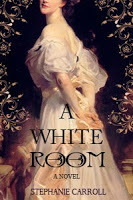 Well the tour is ending this week so no more weak-sauce (and below you’ll see some efforts I’m making to ensure that) but for this post I'm going to give you the sum-up of the blog tour and point you in the direction of the non-weak-sauce posts I’ve been writing and that I think you as my readers may enjoy because a lot of it involves history, gothic Victorian, and other fun stuff.
Well the tour is ending this week so no more weak-sauce (and below you’ll see some efforts I’m making to ensure that) but for this post I'm going to give you the sum-up of the blog tour and point you in the direction of the non-weak-sauce posts I’ve been writing and that I think you as my readers may enjoy because a lot of it involves history, gothic Victorian, and other fun stuff. But first a couple of announcements:
1. I would like to direct your attention to the way too large Rafflecopter widget on the right side of this blog. Why is that there? Well I am having a giveaway. A big freaking giveaway!!!
 Prizes include two $25 Amazon Gift Cards, a signed copy of
Prizes include two $25 Amazon Gift Cards, a signed copy of A White Room, and a 24 hour free share ebook (you get the code to download the free ebook and can give that code to anyone you want online including Facebook and Twitter for a period of 24 hours.)
So how do you enter – it’s super easy. Go to either my author Facebook page or my Twitter page and like/follow me! Bam you are qualified to enter. Then enter using the way too large widget. This also counts if you already do follow me. Super easy right?
 The giveaway will not end until I reach 200 Facebook Followers (I currently have 100) and 450 Twitter followers (I currently have 350) so in order for you to get the opportunity to win, I need your help by sharing this giveaway to your friends!!!
The giveaway will not end until I reach 200 Facebook Followers (I currently have 100) and 450 Twitter followers (I currently have 350) so in order for you to get the opportunity to win, I need your help by sharing this giveaway to your friends!!! 2. If you’ve already forgotten because of that super exciting giveaway I’m doing announcements right now. ;-) Have you noticed the blog’s new look? Yay! I’ve been feeling really bad about neglecting you guys lately, so I’ve decided to renovate around here. Not only do we have a new look and a new mascot The Raven (yes inspired by Poe – I don’t care if it’s cliché it’s really relevant to this site), but we are also going to have some new content round here.
If you were here last week you got to see “Christopher’s Ectoplastic Travels Through Time,” which is the new segment on every fourth Wednesday written by Christopher Thisse an expert in Victorian and turn of the century magical history. Nice!
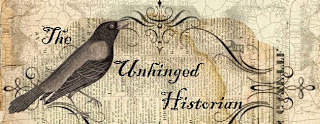 Other segments that are in the works, but I’m not promising anything (although if you hit me up in the comments with some likes I’ll be far more inclined to pursue one segment over another.)
Other segments that are in the works, but I’m not promising anything (although if you hit me up in the comments with some likes I’ll be far more inclined to pursue one segment over another.) Ok other segments I’m working on include: Decrypting the Classics, which will involve me explaining a gothic Victorian classic because sometimes those things are hard to read and understand.
 Another segment and this one really depends on you guys and your wants – I’m a writer. I can totally hook you guys up with a writing/publishing segment, but I got to say that’s only happening if you directly ask for it because I can’t write that segment and make it relevant to the topic of this blog.
Another segment and this one really depends on you guys and your wants – I’m a writer. I can totally hook you guys up with a writing/publishing segment, but I got to say that’s only happening if you directly ask for it because I can’t write that segment and make it relevant to the topic of this blog. And I’m also talking to some other potential guest posters about a Victorian Freak Show Segment and Creepy Civil War History. So let me know what you guys think!
Ok so back to the blog tour. Below are the links directly to my blog tour stops organized into categories to help you find what you most want to check out. Also if you see anything you like and would like me to write more on that type of stuff – shout out in the comments! Just so you know the very last stop on my blog tour is Saturday August 3rd on History and Women: Guest Post: Victorian Women and the Mystery of Sex
Unhinged Posts (Historical or Dark)
Lost to Books: Excerpt from A White Room “The furniture is moving!”
Lost to Books (Halloween 2012 flashback) Evolution of Horror Fiction and Trick of the Trade.
Momma Bears Book Blog: Guest Post: The Story Behind Emeline’s Mental Distress
(To be posted Aug 3) History and Women: Guest Post: Guest Post: Victorian Women and the Mystery of Sex
The Following Posts are Still Historical and Dark but More on Writing
A Writer of History: Guest Post: Writing an Era – Where to Begin?
I am Indeed: Guest Post: Historical Accuracy in Historical Fiction
Reading the Past: Guest Post: Writing and Historical Thought - They Didn't Think Like We Did 100 Years Ago
Reading in Ecuador: Guest Post: How to Write Suspenseful Fiction
Hazel the Witch: Guest Post – How to Write the Inner Thoughts of a Crazy Person
Reviews & Interviews
Oh, For the Hook of a Book: Interview (Includes some interesting Gothic literature questions)
Oh, For the Hook of a Book: Book Review
Hazel the Witch: Interview
The Bookish Dame: Interview
Bookfari: Interview
Review on Bookfari
Satisfaction for Insatiable Readers: Review and Interview.
Taste Testing Tuesdays – a teaser excerpt from A White Room
Michelle’s Romantic Tangle: Interview
Unabridged Chick Review
Unabridged Chick Interview
Ravings and Ramblings: Review and Interview
Published on July 31, 2013 13:07
Announcing: Huge Giveaway, New Segments, and Blog Tour Posts on Victorian, Women's and Gothic Lit History, and Writing How-Tos & Tips!!!!
Hey beloved readers! As many of you are aware, my posts have been a little weak-sauce lately (except for the new segment last week, which was awesome because I didn't write it!). That's because I've been putting all my writing juices into a blog tour for my debut Victorian-Gothic novel A White Room.
 Well the tour is ending this week so no more weak-sauce (and below you’ll see some efforts I’m making to ensure that) but for this post I'm going to give you the sum-up of the blog tour and point you in the direction of the non-weak-sauce posts I’ve been writing and that I think you as my readers may enjoy because a lot of it involves history, gothic Victorian, and other fun stuff.
Well the tour is ending this week so no more weak-sauce (and below you’ll see some efforts I’m making to ensure that) but for this post I'm going to give you the sum-up of the blog tour and point you in the direction of the non-weak-sauce posts I’ve been writing and that I think you as my readers may enjoy because a lot of it involves history, gothic Victorian, and other fun stuff. But first a couple of announcements:
1. I would like to direct your attention to the way too large Rafflecopter widget on the right side of this blog. Why is that there? Well I am having a giveaway. I big freaking giveaway!!!
 Prizes include two $25 Amazon Gift Cards, a signed copy of A White Room, and a 24 hour free share ebook (you get the code to download the free ebook and can give that code to anyone you want online including Facebook and Twitter for a period of 24 hours.)
Prizes include two $25 Amazon Gift Cards, a signed copy of A White Room, and a 24 hour free share ebook (you get the code to download the free ebook and can give that code to anyone you want online including Facebook and Twitter for a period of 24 hours.)So how do you enter – it’s super easy. Go to either my author Facebook page or my Twitter page and like/follow me! Bam you are qualified to enter. Then enter using the way too large widget. This also counts if you already do follow me. Super easy right?
 No…it’s not that easy. =0 There is a catch. I’m not going to end the giveaway until I reach 200 Facebook Followers (I currently have 100) and 450 Twitter followers (I currently have 350) so in order for you to get the opportunity to win, I need your help by sharing this giveaway to your friends!!!
No…it’s not that easy. =0 There is a catch. I’m not going to end the giveaway until I reach 200 Facebook Followers (I currently have 100) and 450 Twitter followers (I currently have 350) so in order for you to get the opportunity to win, I need your help by sharing this giveaway to your friends!!! 2. If you’ve already forgotten because of that super exciting giveaway I’m doing announcements right now. ;-) Have you noticed the blog’s new look? Yay! I’ve been feeling really bad about neglecting you guys lately, so I’ve decided to renovate around here. Not only do we have a new look and a new mascot The Raven (yes inspired by Poe – I don’t care if it’s cliché it’s really relevant to this site), but we are also going to have some new content round here.
If you were here last week you got to see “Christopher’s Ecotplastic Travels Through Time,” which is the new segment on every fourth Wednesday written by Christopher Thisse an expert in Victorian and turn of the century magical history. Nice!
 Other segments that are in the works, but I’m not promising anything (although if you hit me up in the comments with some likes I’ll be far more inclined to pursue one segment over another.)
Other segments that are in the works, but I’m not promising anything (although if you hit me up in the comments with some likes I’ll be far more inclined to pursue one segment over another.) Ok other segments I’m working on include: Decrypting the Classics, which will involve me explaining a gothic Victorian classic because sometimes those things are hard to read and understand.
 Another segment and this one really depends on you guys and your wants – I’m a writer. I can totally hook you guys up with a writing/publishing segment, but I got to say that’s only happening if you directly ask for it because I can’t write that segment and make it relevant to the topic of this blog.
Another segment and this one really depends on you guys and your wants – I’m a writer. I can totally hook you guys up with a writing/publishing segment, but I got to say that’s only happening if you directly ask for it because I can’t write that segment and make it relevant to the topic of this blog. And I’m also talking to some other potential guest posters about a Victorian Freak Show Segment and Creepy Civil War History. So let me know what you guys think!
Ok so back to the blog tour. Below are the links directly to my blog tour stops organized into categories to help you find what you most want to check out. Also if you see anything you like and would like me to write more on that type of stuff – shout out in the comments! Just so you know the very last stop on my blog tour is Saturday August 3rd on History and Women: Guest Post: Victorian Women and the Mystery of Sex
Unhinged Posts (Historical or Dark)
Lost to Books: Excerpt from A White Room “The furniture is moving!”
Lost to Books (Halloween 2012 flashback) Evolution of Horror Fiction and Trick of the Trade.
Momma Bears Book Blog: Guest Post: The Story Behind Emeline’s Mental Distress
(To be posted Aug 3) History and Women: Guest Post: Guest Post: Victorian Women and the Mystery of Sex
The Following Posts are Still Historical and Dark but More on Writing
A Writer of History: Guest Post: Writing an Era – Where to Begin?
I am Indeed: Guest Post: Historical Accuracy in Historical Fiction
Reading the Past: Guest Post: Writing and Historical Thought - They Didn't Think Like We Did 100 Years Ago
Reading in Ecuador: Guest Post: How to Write Suspenseful Fiction
Hazel the Witch: Guest Post – How to Write the Inner Thoughts of a Crazy Person
Reviews & Interviews
Oh, For the Hook of a Book: Interview (Includes some interesting Gothic literature questions)
Oh, For the Hook of a Book: Book Review
Hazel the Witch: Interview
The Bookish Dame: Interview
Bookfari: Interview
Review on Bookfari
Satisfaction for Insatiable Readers: Review and Interview.
Taste Testing Tuesdays – a teaser excerpt from A White Room
Michelle’s Romantic Tangle: Interview
Unabridged Chick Review
Unabridged Chick Interview
Ravings and Ramblings: Review and Interview
Published on July 31, 2013 13:07
Become a VIP Reader Today!
Sign Up Now!
1. Be the First to Know About Free-bees, Giveaways, and Discounts in addition to receiving Email List Only Deals and Prizes!
2. Read Behind the Scenes Material from Published & In-Progress Sign Up Now!
1. Be the First to Know About Free-bees, Giveaways, and Discounts in addition to receiving Email List Only Deals and Prizes!
2. Read Behind the Scenes Material from Published & In-Progress Books and Provide Feedback!
3. Get the Chance to Become a Test Reader and Receive an Advanced Copy for Free!
4. Be the First to Know About New Releases!
5. Learn more about me and my books, while also learning the how-tos of writing and publishing through my experiences.
Sign Up Now!
Email Address
...more
1. Be the First to Know About Free-bees, Giveaways, and Discounts in addition to receiving Email List Only Deals and Prizes!
2. Read Behind the Scenes Material from Published & In-Progress Sign Up Now!
1. Be the First to Know About Free-bees, Giveaways, and Discounts in addition to receiving Email List Only Deals and Prizes!
2. Read Behind the Scenes Material from Published & In-Progress Books and Provide Feedback!
3. Get the Chance to Become a Test Reader and Receive an Advanced Copy for Free!
4. Be the First to Know About New Releases!
5. Learn more about me and my books, while also learning the how-tos of writing and publishing through my experiences.
Sign Up Now!
Email Address
...more
- Stephanie Carroll's profile
- 30 followers



